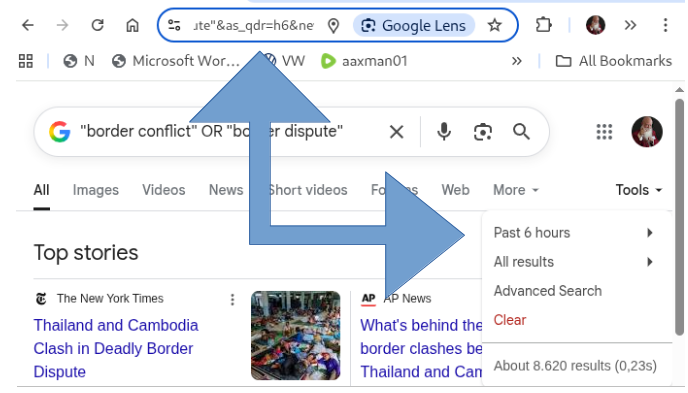Google has a few ways of limiting results by date. It used to be just using daterange: which required a Julian date. That has been replaced by before: and after: search operators. These can be used with a more readable data format such as:
“border conflict” after:1995-05-02 before:1995-05-0
To limit results to just that time frame only to hopefully find what has happened on those dates, instead of all the follow up responses and reactions. Remember, no spaces.
But there is another option too, that requires a little more attention. This option allows to limit results: from the last X hours, or X days or even the last X months. This is a great option to track events, developments, demonstrations, riots etc where you only require ‘the latest’.
The option is called
&as_qdr=PQ
hier is de code weggehaald. P is a unit like ‘h’ for hours, ‘d’ for days and ‘m’ for months. Q is an integer. The complex thing is that this one needs to be added to the URL bar as an extra parameter. Do NOT type this in the search bar!
Examples. Limit results to the last 6 hours only:
https://www.google.com/search?q=”border+conflict”&as_qdr=h6
Limit results to the last 2 days only.
https://www.google.com/search?q=”border+conflict”&as_qdr=d2
Click on the Tools button on the right side of the toolbar to check if your query has actually worked (figure)

Unfortunately, this only applies to the Google search language.
This techniques is useful to monitor developments. First try a query to find out what has happened. Something like:intitle:”border conflict” OR intitle:”border dispute” cambodia thailand
Will probably do the trick. You may want to select the Google News database first. If it is an older conflict, add the after: and before: search parameters to find out what exactly has happened.
Then, when you are happy with the results and your information position, generalise your query a little and add a as_qdr to the URL, save your query as a bookmark on your bookmark toolbar to execute your query at any moment.https://www.google.com/search?q=”border+conflict”+OR+”border+dispute”&as_qdr=h6
Then you add a ‘live’ bookmark. That is, you first develop and run a query suitable for monitoring, then you add a bookmark at your bookmark toolbar. Or even better, in a folder at your bookmark toolbar to prevent clogging up that toolbar too soon.
Now, whenever you click your button, you only get the latest results.Final remarks
Usually you have multiple of these queries for use with different sources. With Google’s site: option, you can select one or more domain names and limit your results further by source. The disadvantage of this techniques is off course you only select results from sources indexed by Google.
More importantly, to use these techniques effectively, first you need to have your requirement analysis and problem deconstruction ready and productive. You need to know what you are going to do, before diving into the tangled information jungle that is called the world wide web. Otherwise, you will get problems with information explosion.


